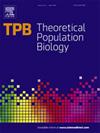无限位点突变模型下时间均匀聚结过程的矩阵解析抽样公式。
IF 1.3
4区 生物学
Q4 ECOLOGY
引用次数: 0
摘要
在本文中,我们建立了计算一个遗传样本在时间均匀聚合过程和无限位点突变模型下的概率的一般框架。我们考虑的进化模型可以被描述为一个两步过程:一个描述样本祖先关系的凝聚过程和一个根据泊松过程在祖先树的不同位置上的零星突变。用多元相型理论定义了聚结过程。需求是决定祖先状态之间转换速率的速率矩阵,初始状态概率向量,以及告知祖先状态特征的奖励矩阵。例如,奖励矩阵可以包含关于祖先状态中单例、双例或高阶谱系的数量的信息。我们将进化模型的概率生成函数分析为初始状态概率向量、转移率矩阵、奖励矩阵和突变率的函数。概率生成函数的矩阵解析表达式使我们能够开发一种计算群体遗传数据集概率的一般方法。我们证明了该方法在计算上对少量突变具有吸引力,并提供了一种简单且易于实现的算法来确定进化模型中样本的概率。该方法计算稳定,只涉及单次矩阵逆运算、矩阵乘法和矩阵加法。我们通过详细的计算和几个基本例子的讨论,提供了对程序的全面理解。这些例子包括不同的样本表示(标记样本和位点频谱)和不同的人口统计学和遗传模型(结构聚结和β聚结)。我们应用抽样公式计算了Kingman聚结和beta聚结的光谱概率。即使对于少量的样本和突变,我们发现光谱的概率也会发生巨大的数量级变化。我们将光谱的概率与田岛的d统计量的值进行比较,发现d统计量对于光谱的概率是一个很差的预测器。最后,我们研究了β -聚结剂的参数化对光谱概率的影响。本文章由计算机程序翻译,如有差异,请以英文原文为准。
A matrix-analytical sampling formula for time-homogeneous coalescent processes under the infinite sites mutation model
In this paper we develop a general framework for calculating the probability of a genetic sample under a time-homogeneous coalescent process and the infinite sites mutation model. The evolutionary model that we consider can be characterized as a two-step procedure: A coalescent process that describes the ancestral relatedness of the samples and a sprinkling of mutations in separate sites on the ancestral tree according to a Poisson process. The coalescent process is defined using multivariate phase-type theory. The requirements are a rate matrix that determines the transition rates between the ancestral states, an initial state probability vector, and a reward matrix that informs about the characteristics of the ancestral states. For example, the reward matrix could contain information about the number of singleton, doubleton or higher-order lineages in the ancestral states. We analyze the probability generating function for the evolutionary model as a function of the initial state probability vector, the transition rate matrix, the reward matrix, and the mutation rate. The matrix-analytical expression of the probability generating function allows us to develop a general method for calculating the probability of a population genetic data set. We demonstrate that the method is computationally attractive for a small number of mutations and provide a simple and easy-to-implement algorithm for determining the probability of a sample from the evolutionary model. The method is computationally stable and only involves a single inverse matrix operation, matrix multiplications and matrix additions. We provide comprehensive understanding of the procedure by detailed calculations and discussions of several elementary examples. These examples include different sample representations (labeled samples and the site frequency spectrum) and different demographic and genetic models (the structured coalescent and the Beta-coalescent). We apply the sampling formula to calculate probabilities of spectra for the Kingman coalescent and the Beta-coalescent. Even for a small number of samples and mutations we find that the probabilities for spectra vary in huge orders of magnitudes. We compare the probabilities of the spectra to the values of Tajima’s -statistics, and find that the -statistic is a poor predictor for the probability of a spectrum. Finally, we investigate how the probabilities of the spectra vary with the parametrization of the Beta-coalescent.
求助全文
通过发布文献求助,成功后即可免费获取论文全文。
去求助
来源期刊

Theoretical Population Biology
生物-进化生物学
CiteScore
2.50
自引率
14.30%
发文量
43
审稿时长
6-12 weeks
期刊介绍:
An interdisciplinary journal, Theoretical Population Biology presents articles on theoretical aspects of the biology of populations, particularly in the areas of demography, ecology, epidemiology, evolution, and genetics. Emphasis is on the development of mathematical theory and models that enhance the understanding of biological phenomena.
Articles highlight the motivation and significance of the work for advancing progress in biology, relying on a substantial mathematical effort to obtain biological insight. The journal also presents empirical results and computational and statistical methods directly impinging on theoretical problems in population biology.
 求助内容:
求助内容: 应助结果提醒方式:
应助结果提醒方式:


